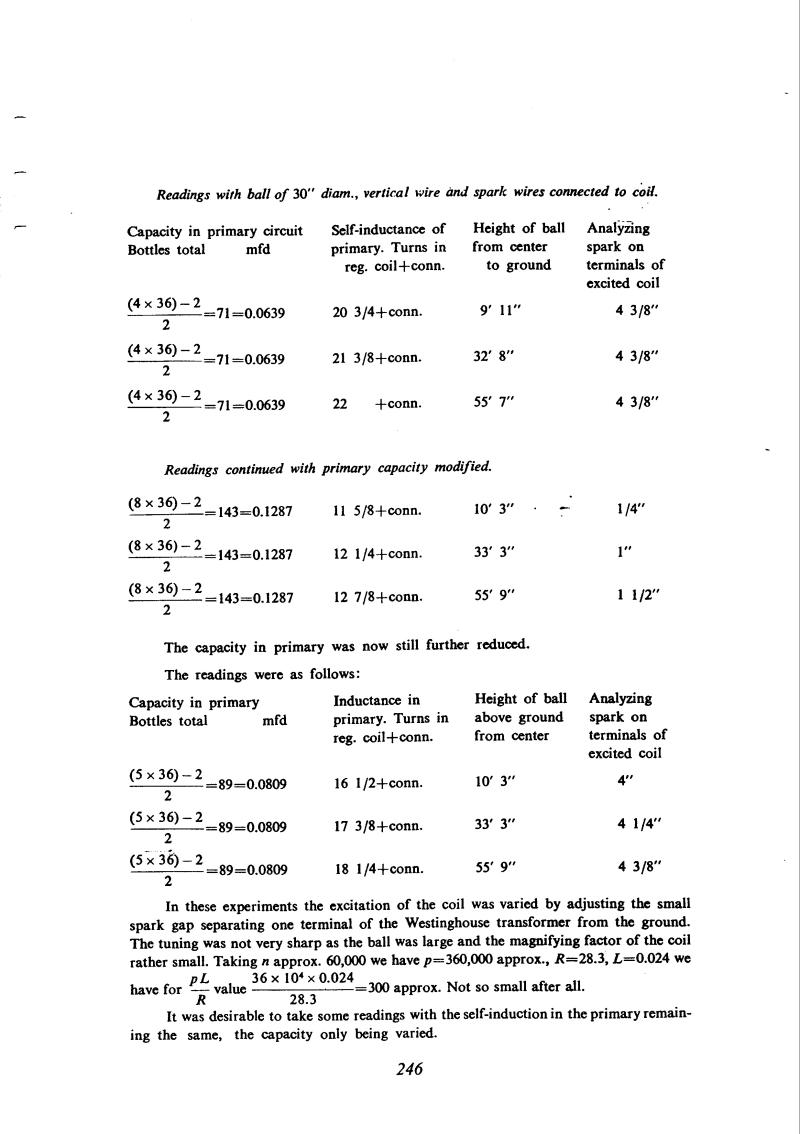
Nikola Tesla Books
Readings with ball of 30" diam., vertical wire and spark wires connected to coil.
| Capacity in primary circuit | Self-inductance of primary. Turns in reg. coil + conn. | Height of ball from center to ground | Analyzing spark on terminals of excited coil | |
|---|---|---|---|---|
| Bottles total | mfd | |||
| $! {{\left({4 \times 36}\right) - 2} \over 2} $! = 71 | = 0.0639 | 20 3/4 + conn. | 9' 11" | 4 3/8" |
| $! {{\left({4 \times 36}\right) - 2} \over 2} $! = 71 | = 0.0639 | 21 3/8 + conn. | 32' 8" | 4 3/8" |
| $! {{\left({4 \times 36}\right) - 2} \over 2} $! = 71 | = 0.0639 | 22 + conn. | 55' 7" | 4 3/8" |
Readings continued with primary capacity modified.
| Capacity in primary circuit | Self-inductance of primary. Turns in reg. coil + conn. | Height of ball from center to ground | Analyzing spark on terminals of excited coil | |
|---|---|---|---|---|
| Bottles total | mfd | |||
| $! {{\left({8 \times 36}\right) - 2} \over 2} $! = 143 | = 0.1287 | 11 5/8 + conn. | 10' 3" | 1/4" |
| $! {{\left({8 \times 36}\right) - 2} \over 2} $! = 143 | = 0.1287 | 12 1/4 + conn. | 33' 3" | 1" |
| $! {{\left({8 \times 36}\right) - 2} \over 2} $! = 143 | = 0.1287 | 12 7/8 + conn. | 55' 9" | 1 1/2" |
The capacity in primary was now still further reduced.
The readings were as follows:
| Capacity in primary | Inductance in primary. Turns in reg. coil + conn. | Height of ball above ground from center | Analyzing spark on terminals of excited coil | |
|---|---|---|---|---|
| Bottles total | mfd | |||
| $! {{\left({5 \times 36}\right) - 2} \over 2} $! = 89 | = 0.0809 | 16 1/2 + conn. | 10' 3" | 4" |
| $! {{\left({5 \times 36}\right) - 2} \over 2} $! = 89 | = 0.0809 | 17 3/8 + conn. | 33' 3" | 4 1/4" |
| $! {{\left({5 \times 36}\right) - 2} \over 2} $! = 89 | = 0.0809 | 18 1/4 + conn. | 55' 9" | 4 3/8" |
In these experiments the excitation of the coil was varied by adjusting the small spark gap separating one terminal of the Westinghouse transformer from the ground. The tuning was not very sharp as the ball was large and the magnifying factor of the coil rather small. Taking n approx. 60,000 we have p = 360,000 approx., R = 28.3, L = 0.024 we have for $! {p L \over R} $! value $! {{{36 \times 10^{4} \times 0.024} \over 28.3} = 300} $! approx. Not so small after all.
It was desirable to take some readings with the self-induction in the primary remaining the same, the capacity only being varied.
246
October 29
His remark about eddy currents in the sphere is interesting. To prevent their formation he slit the tinfoil with a knife. Did he assume that in the vicinity of the coil the sphere would behave like a short-circuited turn? It is readily shown that if this effect is pronounced (and not taken into account) the measured capacity of the sphere will be too low. This might be an explanation for the reduction of the effective capacity of the sphere in the lowest position (see the calculation of October 28th for an 18" sphere in the lowest position).
October 29
It contains a new measurement series with larger sphere and somewhat changed excitation of the measurement circuit. The excitation is now regulated by an adjustable arcing gap between the lower coil L terminal and grounding (for other details of the scheme please see Oct. 23). The note related to eddy-currents on the globe is very interesting. In order to prevent the occurrence of these currents Tesla makes slits in the metal foil by knife. Did Tesla assume that the sphere in the vicinity of the coil acts like a short circuited turn or something similar? If this effect is distinct and neglected, it is easy to show that the measure value for the sphere will be smaller than actual. It is possible that this effect causes the effective globe capacitance reduction in the lowest position (please see the calculated value obtained on Oct. 28 for the sphere of 18" diameter in the lowest position.)
In some cases Tesla finds that the resonance adjustment is not sharp. By calculation he checks the coil validity factor. The actual validity factor is certainly smaller because Tesla takes the coil resistance at direct current.

